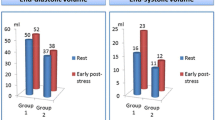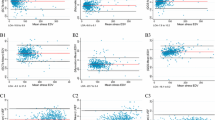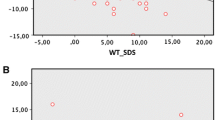Abstract
Purpose
The aim of this study was the evaluation of septal wall motion, perfusion and wall thickening after CABG in two groups of consecutive patients, one with grafted left anterior coronary artery and no history of myocardial infarction, and the other with previous anteroseptal myocardial infarction and impaired septal motion before surgery. The issue addressed was the ability of gated SPECT to differentiate between true paradoxical septal motion, characterised by paradoxical wall motion, depressed ejection fraction (EF), poor viability and compromised wall thickening, and pseudo-paradoxical motion, characterised by abnormal wall motion and regional EF but preserved perfusion and wall thickening.
Methods
One hundred and thirty-two patients with previous anterior myocardial infarction, 82 patients with left anterior descending coronary disease and no history of myocardial infarction and 27 normal subjects underwent rest gated SPECT after 99mTc-sestamibi injection, according to the standard QGS protocol. Quantitative regional EF, regional perfusion, regional wall motion and regional wall thickening were determined using a 20-segment model.
Results
Despite the presence of similar regional wall motion impairment in patients with and patients without septal infarction, in terms of regional EF (2.5%±3% vs 1.9%±4.9% p=NS) and inward septal motion (3±4.9 mm vs 2.3±6.1 mm p=NS), significant differences were observed in both perfusion (74.7%±6.2% vs 63.3%±13%, p>0.0001) and regional wall thickening (17.2%±7.4% vs 12.6%±7.2%, p>0.0001).
Conclusion
Gated SPECT with perfusion tracers can reliably differentiate pseudo-paradoxical from true paradoxical septal motion in patients with previous CABG, and it may be the method of choice for evaluating left ventricular performance in this patient population.










Similar content being viewed by others
References
Akins CW, Boucher CA, Pohost GM. Preservation of interventricular septal function in patients having coronary artery bypass grafts without cardiopulmonary bypass. Am Heart J 1984;107(2):304–9
Okada RD, Murphy JH, Boucher CA, Pohost GM, Strauss HW, Johnson G III, Daggett WM. Relationship between septal perfusion, viability, and motion before and after coronary artery bypass surgery. Am Heart J 1992;124(5):1190–5
Germano G, Kiat H, Kavanagh PB, et al. Automatic quantification of ejection fraction from gated myocardial perfusion SPECT. J Nucl Med 1995;36:2138–47
Germano G, Erel J, Lewin H, Kavanagh PB, Berman DS. Automatic quantitation of regional myocardial wall motion and thickening from gated technetium-99m sestamibi myocardial perfusion single-photon emission computed tomography. J Am Coll Cardiol 1997;30:1360–7
Sharir T, Berman DS, Waechter PB, et al. Quantitative analysis of regional motion and thickening by gated myocardial perfusion SPECT: normal heterogeneity and criteria for abnormality. J Nucl Med 2001;42:1630–8
Nakata T, Katagiri Y, Odawara Y, et al. Two-dimensional and three-dimensional assessments of myocardial perfusion and function by using technetium-99m sestamibi gated SPECT with a combination of count- and image-based techniques. J Nucl Cardiol 2000;7:623–32
Chua T, Kiat H, Germano G, et al. Gated technetium-99m sestamibi for simultaneous assessment of stress myocardial perfusion, postexercise regional ventricular function and myocardial viability: correlation with echocardiography and rest thallium-201 scintigraphy. J Am Coll Cardiol 1994;23:1107–14
Berman D, Germano G. An approach to the interpretation and reporting of gated myocardial perfusion SPECT. In: Germano G, Berman D, eds. Clinical gated cardiac SPECT. Armonk, New York: Futura Publishing; 1999:147–82
Kerber RE, Litchfield R. Postoperative abnormalities of interventricular septal motion: two-dimensional and M-mode echocardiographic correlations. Am Heart J 1982;104:263–8
Righetti A, Crawford MH, O’Rourke RA, et al. Interventricular septal motion and left ventricular function after coronary bypass surgery: evaluation with echocardiography and radionuclide angiography. Am J Cardiol 1977;39:372–7
Waggoner AD, Shah AA, Schuessler JS, et al. Effect of cardiac surgery on ventricular septal motion: assessment by intraoperative echocardiography and cross-sectional two-dimensional echocardiography. Am Heart J 1982;104:1271–8
Lehmann KG, Lee FA, McKenzie WB, et al. Onset of altered interventricular septal motion during cardiac surgery: assessment by continuous intraoperative transesophageal echocardiography. Circulation 1990;82:1325–34
Kubo S, Tadamura E, Kudoh T, et al. Assessment of the effect of revascularization early after CABG using ECG-gated perfusion single-photon emission tomography. Eur J Nucl Med 2001;28:230–9
Taki J, Higuchi T, Nakajima K, Matsunari I, Hwang EH, Bunko H, Kawasuji M, Watanabe G, Tonami N. Electrocardiographic gated 99mTc-MIBI SPECT for functional assessment of patients after coronary artery bypass surgery: comparison of wall thickening and wall motion analysis. J Nucl Med 2002;43:589–95
Hida S, Chikamori T, Hirayama T, Usui Y, Yanagisawa H, Morishima T, Ishimaru S, Yamashina A. Beneficial effect of coronary artery bypass grafting as assessed by quantitative gated single-photon emission computed tomography. Circ J 2003;67:499–504
Lam WWM, So NMS, Chan A, Sanderson JE, Metreweli C. Magnetic resonance imaging in ischaemic heart disease. Hong Kong Med J 2003;9:370–6
Manrique A, Tapon E, Derumeaux G, Cribier A, Vera P, Dacher JN. Cine-MR Fourier phase imaging for quantification of regional wall asynergy in patients with anterior myocardial infarction. J Comput Assist Tomogr 2002;26(5):676–80
Author information
Authors and Affiliations
Corresponding author
Rights and permissions
About this article
Cite this article
Giubbini, R., Rossini, P., Bertagna, F. et al. Value of gated SPECT in the analysis of regional wall motion of the interventricular septum after coronary artery bypass grafting. Eur J Nucl Med Mol Imaging 31, 1371–1377 (2004). https://doi.org/10.1007/s00259-004-1569-y
Received:
Accepted:
Published:
Issue Date:
DOI: https://doi.org/10.1007/s00259-004-1569-y




